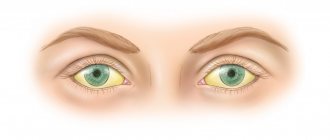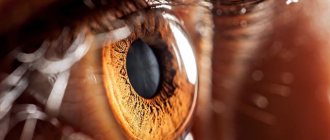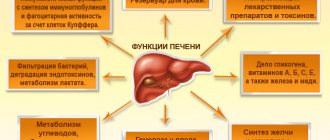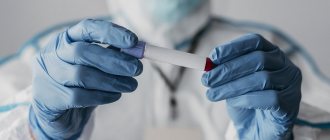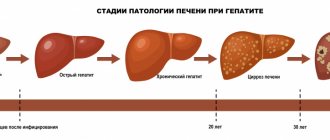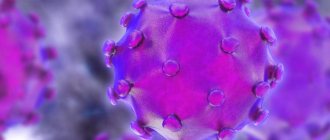Author:
- Nikonov Mikhail Yurievich
5.00 (Votes: 1)
Many of us begin to think about the state of our health only when we hear an alarm bell from it, or even several. This also applies to the liver, the hottest organ of our body, which bears special responsibility for numerous and very important processes occurring in it.
For example, our liver courageously takes on the first “blow” of toxic substances, allergens and other substances that are unsafe for us (including metabolic products), practically transforming them into safer ones and ready for elimination from the body. It also comes with an excess of hormones, vitamins and other elements that are beneficial to us in normal doses.
On the other hand, the liver accumulates reserves of useful substances (for example, glycogen, vitamins and microelements) to regulate carbohydrate metabolism and a large amount of blood (in case of emergency compensation for blood loss). The liver also synthesizes hormones and enzymes, blood plasma proteins, cholesterol and lipids, bile (including the specific pigment bilirubin), without which our body simply could not exist.
During our lives, the liver copes with such a huge amount of work that if the load on it is too great, sooner or later it itself may need our help. Therefore, assessing the condition of our liver and nearby organs in time by undergoing a comprehensive ultrasound of the abdominal organs and kidneys with the adrenal glands means noticing alarming changes and starting the necessary treatment as early as possible!
What is jaundice
First of all, by jaundice we should not mean a specific disease (for example, hepatitis, as many people think), but a whole symptomatic complex that arises as a result of pathological processes in the liver and some organs. Essentially, jaundice is an excess amount of bilirubin in the body, which is externally manifested by the sclera, mucous membranes and skin becoming yellow.
Normally, bilirubin is formed in the liver and spleen from hemoglobin as a result of the breakdown of red blood cells, after which it is converted by the liver into bile and excreted from the body. With jaundice, the normal process of conversion and excretion of bilirubin is disrupted, so it remains almost completely in the blood, slightly excreted through the kidneys and skin.
People with:
- neoplasms in the liver;
- congenital anomalies of the bile ducts;
- pathological processes in the liver and gall bladder;
- the presence of parasitic organisms;
- postoperative complications;
- post-reaction to certain medications.
Causes of the disease
The most common cause of obstructive jaundice is complete or partial closure of the bile ducts.
However, other factors can also provoke the disease:
- inflammation of the gallbladder (cholecystitis);
- inflammation of the bile ducts (cholangitis);
- cholelithiasis;
- cysts in the bile duct area;
- hepatitis;
- liver cirrhosis, ascites;
- inflammation of the pancreas;
- tumor neoplasms in the area of the duodenum, liver, stomach;
- parasitosis;
- a sharp increase in hepatic lymph nodes;
- complication resulting from surgery in the biliary tract.
Types of jaundice
Depending on the reasons that caused jaundice, it is divided into forms:
- physiological (neonatal) - usually occurring in newborns (more often in weakened or premature infants) due to the adaptation of an immature enzyme system to new environmental conditions;
- parenchymal (liver) - usually occurring when the structure and function of liver cells (hepatocytes) are disrupted due to neoplasms and drug effects on the liver, or hepatitis or cirrhosis;
- hemolytic (suprahepatic) - usually occurring when red blood cells are destroyed and indirect bilirubin increases in anemia, lymphocytic leukemia, lymphosarcoma or tropical malaria;
- conjugation – usually occurring when the liver is exposed to provoking factors and congenital pathologies;
- mechanical (subhepatic) - usually occurring when direct bilirubin increases due to the inability to remove it through bile ducts blocked (by stones, tumors or helminths).
According to the duration of its course, jaundice is divided into:
- spicy;
- protracted;
- chronic.
Diagnosis of jaundice
Typically, the danger is not caused by jaundice itself, but by the pathologies that caused it. As a result of intoxication of the body with bilirubin, a serious failure of its various systems can occur, and in young children - mental retardation. Therefore, accurate diagnosis of this condition is so important, for which they carry out:
- comprehensive ultrasound of the abdominal cavity and retroperitoneal space;
- laboratory blood tests (general and biochemical blood tests);
- liver functional studies;
- liver biopsy.
Prevention
Obstructive jaundice can affect any organism. However, there are a number of factors that can trigger its appearance. In this regard, it is recommended to follow simple preventive measures.
These include:
- timely detection and competent treatment of gallbladder diseases, as well as any malfunctions in the functioning of the hepatobiliary system;
- maintaining a healthy diet that excludes the consumption of fatty, fried, and excessively sweet foods;
- giving up alcohol;
- moderate physical activity;
- body weight regulation.
What is hepatitis
Hepatitis is an inflammatory process in the liver under the influence of a provoking (in most cases viral) agent, causing damage to its tissues.
Today, hepatitis is considered one of the most common infectious diseases after ARVI, influenza and chickenpox. Most often, the disease is diagnosed in young people aged 15-30 years (especially those prone to unprotected sex and drug use), another “risk group” is usually represented by medical specialists who have direct contact with blood (including infected people).
What are the symptoms of hepatitis
It must be remembered that the symptoms of hepatitis can be vivid, but sometimes they can be almost completely absent (giving time for the undetected disease to become chronic). However, quite often all types of hepatitis are characterized by common symptoms of any intensity:
- jaundice;
- change in urine color (darkening to brown)
- pain (often pressing) in the liver area;
- indigestion (nausea, vomiting with a bitter taste, diarrhea or constipation);
- weakness and increased fatigue;
- increased body temperature and headache;
- skin itching;
- increased liver size.
Hepatitis classification
In its form, hepatitis can be acute or chronic.
Depending on the provoking factor, hepatitis is divided into:
- infectious (caused by viruses or bacteria);
- toxic (when the body is poisoned with alcohol, chemicals or drugs);
- autoimmune (caused by autoimmune pathologies);
- radiation (for example, as a consequence of radiation therapy).
Viral hepatitis, in turn, is divided into types (depending on the virus that provokes the disease):
- hepatitis A (Botkin's disease) - transmitted through contaminated food and water, with an incubation period of 2-6 weeks, after the disease giving lifelong immunity to this type;
- hepatitis B - transmitted through unprotected sexual contact and through open access to blood (at home, dentistry, cosmetology, etc.) using unsterilized instruments, with an incubation period of 1.5-6 months, the duration of the acute disease is from 6 to 8 weeks (with recovery in 90% of cases) and rare transition to chronic;
- hepatitis C is the most dangerous type, transmitted in the same way as hepatitis B, but with almost unnoticeable symptoms, which is why the disease can proceed unnoticed by the patient for years in a chronic form, leading to cirrhosis and liver cancer;
- hepatitis D – transmitted in the same way as hepatitis B and C, but developing only after infection with the hepatitis B virus, easily becoming chronic and ending in cirrhosis of the liver;
- hepatitis E is transmitted in the same way as hepatitis A, with similar symptoms, usually common in African and Asian countries.
Why do people turn yellow?
Many people commonly associate the term “jaundice” with hepatitis. But is this always the case? Let's figure it out.
What's normal?
The prerequisites for the development of jaundice are disturbances in metabolism, excretion and, as a consequence, excessive accumulation of bilirubin in the tissues. It is formed as a result of the breakdown of expired red blood cells, cytochromes, and myoglobin.
There are two forms of bilirubin: unbound (or, otherwise, indirect) and bound (direct). Unbound bilirubin is toxic; normally it combines with the protein albumin and enters the liver through the bloodstream. Liver cells bind bilirubin with glucuronic acid and convert it into conjugated bilirubin. As part of the bile produced by the liver, bilirubin enters the intestines and is excreted in the feces.
There are two forms of bilirubin:
unrelated (or otherwise indirect)
and connected (direct)
Why does jaundice occur?
If changes occur at any stage of bilirubin metabolism, jaundice may develop. In this regard, the following types are distinguished:
Physiological jaundice.
It happens in children due to immaturity of the liver tissue. It appears in 60-70% of newborns on the 3rd-4th day of birth. It is more often registered in children born prematurely and is associated with the body’s adaptation to a new environment. In this case, jaundice disappears after 1-2 weeks (in premature babies - after 3-4 weeks) and does not harm the baby.
Hemolytic jaundice.
It develops as a result of the active destruction of red blood cells and the conversion of released hemoglobin into bilirubin. This type of jaundice may be a consequence of certain types of anemia, a violation of the structure of the hemoglobin protein. Red blood cells can also be destroyed by a number of medications and poisons. The cause of this type of jaundice is the Rh conflict between the woman and the fetus.
Parenchymal (liver) jaundice.
Caused by inflammation of the liver tissue caused by hepatitis viruses, toxins, hypoxia (lack of oxygen in the blood) or an autoimmune process in which liver cells are destroyed by the body's own immune system.
“The best known are hepatitis viruses A, B, C, D, E, F, G.” Quote from the material “Shield and sword against hepatitis C. How to protect yourself and your loved ones?”
Mechanical jaundice.
They talk about it when there is a violation of the outflow of bile from the liver into the duodenum. Some of the reasons contributing to the development of obstructive jaundice:
- stones and neoplasms in the bile ducts, narrowing and inflammation of the ducts;
Gallstone disease is dangerous due to its complications. Among them are cholecystitis; blockage of the gallbladder duct; obstructive jaundice; formation of fistulas (including between the gallbladder and intestine)…
You can read more about gallstone disease in our article
- tumors of the liver and pancreas;
- helminths - roundworms, in the intestinal phase of existence. They are capable of spiral movements forward, and, trying to penetrate narrow openings, can lead to serious complications: blockage of the bile ducts and their inflammation, which is manifested by obstructive jaundice and pancreatitis.
“The consequences of acute pancreatitis can be, in particular, the formation of cysts, necrosis of gland tissue, and the formation of ulcers in it.” Quote from the material “Acute pancreatitis: prevent and neutralize”
In addition, helminthiasis also contributes to the development of anemia. The red blood cells formed in this case have a shorter lifespan than normal, and therefore their breakdown (hemolysis) increases. This can also cause the appearance of jaundice.
Among other things, jaundice can be acute or chronic. If in an acute course all symptoms appear simultaneously and rapidly increase, then the chronic process is characterized by the gradual manifestation of symptoms, the change in intensity of which is associated with the course of the primary disease.
Among the serious causes of yellow skin, in addition to a number of pathologies of the digestive and blood organs, there may be disturbances in the functioning of the cardiovascular, endocrine system and lipid metabolism.
Important to remember:
A person can also “turn yellow” if the body is oversaturated with carotene. This effect is observed with excessive consumption of beets, pumpkin, carrots, citrus fruits, and persimmons. It is not difficult to distinguish false jaundice from true jaundice in this case - carotene stains only the skin, and the mucous membranes have their usual color. A similar coloration can also occur as a response to excessive intake of picric acid or medications containing acryquine.
Another reason for yellowing of the skin can be excessive consumption of various spices, fatty and spicy foods, prolonged fasting, alcohol abuse and drug use, etc.
How does jaundice manifest?
The symptoms accompanying jaundice syndrome depend on its type.
For example, jaundice due to viral hepatitis is characterized by the coloring of the skin and mucous membranes in a bright yellow-orange color against the background of loss of appetite, nausea, and vomiting. Patients' urine darkens and their stool becomes discolored.
The skin, sclera, and mucous membranes with jaundice that develops against the background of a pancreatic tumor become yellow in color with a greenish or gray tint. The patient quickly loses weight and complains of unbearable itching of the skin. In this case, feces become white, and urine the color of dark beer.
“The so-called acholic stool (light-colored) is characteristic of patients with diseases of the hepatobiliary system.” Quote from the material “Not only a colonoscopy: what will a stool test tell you?”
How to diagnose jaundice
To identify jaundice syndrome and the diseases in which it is observed, laboratory diagnostics and some other research methods are necessary. The following methods are considered informative in this case:
- general blood analysis. Thanks to it, you can, in particular, find out the level of hemoglobin and suspect the presence of an inflammatory process in the body;
- blood chemistry. Makes it possible to evaluate the content of total bilirubin and its fractions, liver enzymes, etc.;
— study of thyroid hormones, lipid profile;
— test for roundworms;
— analysis for tumor markers – CA19-9, C242, CEA;
- General urine test for jaundice. Necessary for determining the level of bilirubin and its derivatives;
— immunological analysis to detect antibodies to hepatitis viruses;
— PCR (polymerase chain reaction) to detect hepatitis viruses;
- antiglobulin test, which determines the likelihood of the risk of developing hemolytic jaundice in newborns;
—
fibrogastroduodenoscopy, ultrasound, CT and MRI of the abdominal organs will reveal inflammatory, tumor changes, and stones in the bile ducts.
The selection of the necessary diagnostic methods for a particular patient is made by the doctor who initially assessed the complaints, symptoms and suggested a possible cause for the development of the syndrome.
Treatment of jaundice
It directly depends on the underlying pathological process, the manifestation of which is jaundice, and is carried out by specialists of the relevant profile (gastroenterologist, infectious disease specialist, hematologist, surgeon, oncologist, endocrinologist, cardiologist).
Prevention of diseases accompanied by jaundice syndrome
You can prevent the development of jaundice by following simple recommendations:
— observe the rules of personal hygiene;
- monitor your diet;
- do not eat food in unsanitary conditions;
— avoid contact with virus carriers;
— observe occupational and rest hygiene;
— undergo a scheduled medical examination;
- promptly seek help from a medical facility if any symptoms occur.
Sevil Ibraimov
The article was prepared with the advisory support of specialists from Clinic Expert Smolensk
The editors recommend:
How to prepare for an abdominal ultrasound?
Where can I find the courage to make up my mind? Gastroscopy – without fear!
Acute pancreatitis: prevent and neutralize
Is it possible to cleanse the liver?
What is liver cirrhosis
Liver cirrhosis is a pathological and chronic process in the liver, as a result of which its parenchymal tissue is replaced by fibrous connective tissue (stroma). There is also a structural restructuring of the vascular bed and a decrease in the number of normally functioning hepatocytes (liver cells).
According to statistics, the global annual mortality rate from cirrhosis is about 300 thousand people, with a progressive upward trend. The disease most often affects men over 40 years of age, those prone to alcoholism, as well as patients with:
- chronic hepatitis B, C and D;
- pathologies complicated by fatty hepatosis;
- some hereditary diseases (for example, hemochromatosis);
- some autoimmune diseases;
- toxic liver damage from chemicals.
What are the symptoms of cirrhosis
Symptoms of cirrhosis may be completely absent for quite a long time, or appear slightly. Most often, the disease can begin to manifest itself:
- increased fatigue and decreased mental activity, weakness and irritability;
- indigestion (a feeling of bitterness in the mouth, nausea and vomiting, flatulence and upset stool), especially in the morning;
- pain in the right hypochondrium (increased after drinking alcohol or fatty foods, as well as during physical activity);
- increased bleeding in the mucous membranes and subcutaneous hemorrhages (with characteristic spider veins at the top of the body and redness of the palms);
- itchy skin and aching joints.
A long-term progressive disease is also characterized by:
- decrease in body weight and muscle volume;
- “protrusion” of the abdomen (against the background of thinning limbs with thickening fingertips) with an enlarged liver and spleen, ascites;
- painful swelling of the joints;
- jaundice;
- decreased sexual function and secondary sexual characteristics.
Ways to prevent disease
In order to prevent the occurrence of obstructive jaundice, the following actions must be taken:
- Regular checking and treatment of gallstone disease,
- Diagnosis of chronic infections of the hepatobiliary system,
- Maintaining a proper diet (reducing the consumption of fried and fatty foods, split meals),
- Reducing the consumption of alcoholic beverages or completely quitting,
- Increasing activity and maintaining a healthy lifestyle,
- Bringing body weight back to normal.
Signs of obstructive jaundice also include dark urine, discolored stool, and itchy skin.
Diagnosis of cirrhosis
Diagnosis of the disease is based on the results of a comprehensive examination of the condition of the liver and organic systems most closely related to its work, as well as establishing the causes of cirrhosis. To do this:
- comprehensive ultrasound of the abdominal organs and retroperitoneal space (kidneys and adrenal glands), as well as portal vessels;
- laboratory blood test (including biochemical, for the presence of hepatitis viruses, as well as a coagulogram);
- esophagogastroduadenoscopy to identify dilated veins of the esophagus;
- liver biopsy and scintigraphy.
Treatment of cirrhosis
Typically, treatment of liver cirrhosis is aimed at stopping (in the initial stages of the disease) or slowing down progressive pathological processes. Conservative therapy is strictly individual and often consists of:
- taking medications (hepatoprotectors);
- following a diet (with the obligatory exclusion of alcohol, fatty and canned foods);
- excluding physical and emotional overload.
Treatment of end-stage cirrhosis can only be associated with liver transplantation.
It must be remembered that only a preventive comprehensive ultrasound of the abdominal organs in most cases can help to recognize pathological changes in the liver in time, even before the first symptoms appear! Save your health!
Consequences and prognosis for obstructive jaundice
The prognosis will be favorable in cases where the treatment of jaundice was timely and correct. The behavior of the patient himself is also of great importance. If you adhere to the principles of proper nutrition and strictly follow all the doctor’s instructions, the risk of relapse or complications will be minimal. Otherwise, the likelihood of recurrent obstructive jaundice will be very high. In addition, the risk of developing concomitant diseases, for example, liver failure, liver cirrhosis, encephalopathy, sepsis, etc., will increase.

